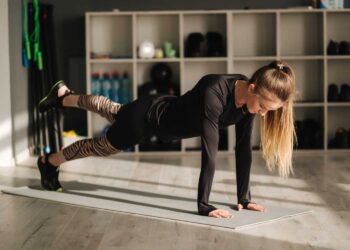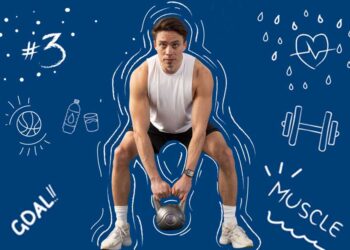Are you searching for the perfect formula to achieve optimal health? Many believe that a healthy and balanced lifestyle lies in the delicate dance between nutrition and physical activity. But how exactly do these two pillars of well-being integrate to promote holistic health? Join us as we dive into the world of nutrition and exercise, exploring the synergistic relationship between food and fitness. Discover the secrets to unlocking wellness through a balanced approach to nutrition and exercise, and learn how to harness the power of food and physical activity synergy to promote overall well-being.
Key Takeaways:
- Integrating nutrition with physical activity is key to achieving optimal health and well-being.
- A balanced approach to nutrition and exercise promotes overall wellness.
- Food and exercise synergy plays a crucial role in promoting a healthy lifestyle.
- Discover the secrets to maintaining optimal health habits through nutrition and fitness integration.
- Unlock the potential of holistic health practices to promote well-being through nutrition and physical activity.
The Benefits of Regular Exercise
Regular exercise offers a multitude of benefits for both the body and mind. Incorporating physical activity into your routine can lead to improved mental function, reduced risk of chronic diseases, effective weight management, increased energy levels, better sleep quality, enhanced mood, and even improved sexual health.
Engaging in regular exercise is crucial for maintaining overall health and well-being. It has been shown to improve mental function, making exercise an excellent tool for boosting cognitive abilities and promoting a healthy brain.
“Exercise improves circulation, increases oxygen flow to the brain, and stimulates the production of hormones that enhance brain function. This can lead to improved memory, cognitive performance, and overall mental well-being.” – Dr. Jane Thompson, Neurology Specialist
In addition to mental health benefits, regular exercise plays a key role in preventing chronic diseases such as heart disease, diabetes, and certain cancers. Physical activity helps to manage weight by burning calories and increasing metabolism, making it an effective tool for weight control.
“Engaging in regular exercise and maintaining a healthy weight can significantly reduce the risk of developing chronic diseases. Exercise promotes a healthy cardiovascular system, improves blood sugar regulation, and supports overall cellular health, reducing the likelihood of developing conditions like heart disease, diabetes, and certain types of cancer.” – Dr. James Adams, Cardiologist
Exercise also plays a crucial role in managing energy levels. Regular physical activity boosts stamina and endurance, allowing individuals to perform daily tasks with ease and maintain an active lifestyle.
Moreover, exercise has a significant impact on sleep quality. Engaging in physical activity promotes better sleep patterns, leading to improved sleep duration and overall sleep quality.
“Regular exercise promotes the release of endorphins, which are neurotransmitters that help regulate mood and promote relaxation. This can contribute to improved sleep, as exercise helps to relieve stress and tension, allowing for more restful sleep.” – Dr. Sarah Lewis, Sleep Specialist
One of the lesser-known benefits of exercise is its positive impact on sexual health. Regular physical activity has been shown to enhance sexual function, libido, and overall satisfaction.
Exercise has a profound impact on overall well-being. By incorporating regular physical activity into your routine, you can experience improved mental function, reduced risk of chronic diseases, effective weight management, increased energy levels, better sleep quality, enhanced mood, and even improved sexual health.
Types of Exercise to Incorporate
When it comes to creating an effective fitness routine, incorporating a variety of exercises is key to achieving optimal results. Whether you’re looking to improve cardiovascular fitness, increase muscle strength, enhance flexibility, or boost overall health, it’s important to include a mix of different exercise types. Here are some types of exercises that you can incorporate into your fitness routine:
Aerobic Exercise
Aerobic exercises, also known as cardio exercises, are great for improving cardiovascular fitness and burning calories. These exercises elevate your heart rate and increase your breathing rate, improving the efficiency of your heart and lungs. Some examples of aerobic exercises include swimming, running, cycling, dancing, and brisk walking.
Strength Training
Strength training exercises are essential for building muscle strength and power. These exercises involve resistance against external weights or body weight, challenging your muscles and promoting muscle growth. Incorporating strength training exercises can help improve bone health, increase metabolism, and enhance overall strength. Examples of strength training exercises include weightlifting, using resistance bands, and bodyweight exercises like push-ups and squats.
Calisthenics
Calisthenics exercises use your body weight as resistance to build strength, endurance, and flexibility. These exercises help improve muscular endurance, promote functional movement patterns, and require minimal equipment. Calisthenics exercises include movements like push-ups, pull-ups, lunges, planks, and burpees.
High-Intensity Interval Training (HIIT)
High-Intensity Interval Training (HIIT) involves short bursts of intense exercise followed by periods of rest or low-intensity exercise. HIIT workouts are known for their efficiency in burning calories and improving cardiovascular fitness. Incorporating HIIT into your routine can help boost metabolism, increase endurance, and improve overall fitness. HIIT exercises can include sprints, high-intensity bodyweight exercises, or using equipment like kettlebells or battle ropes.
Boot Camps
Boot camps are group workout sessions that combine cardio exercises, strength training, and interval training. These sessions are often designed to challenge participants and provide a full-body workout. Boot camps can be a fun and motivating way to mix different exercise types and enjoy the benefits of a group workout environment.
Balance Exercises
Balance exercises are important for improving stability and preventing falls, especially as we age. These exercises focus on enhancing muscle strength, coordination, and body control. Examples of balance exercises include standing on one leg, yoga poses like tree pose, or using stability balls or balance boards.
Flexibility Exercises
Flexibility exercises are essential for maintaining joint mobility, preventing muscle imbalances, and reducing the risk of injury. These exercises help improve muscle recovery, range of motion, and overall flexibility. Stretching exercises, yoga, and Pilates are common forms of flexibility exercises.
Exercise Combinations
Combining different types of exercises can provide a well-rounded fitness program that targets multiple aspects of fitness. For example, you can create a workout routine that includes a combination of aerobic exercises, strength training, and flexibility exercises. This approach allows you to reap the benefits of various exercise types and work towards your specific fitness goals.
By incorporating a mix of aerobic exercise, strength training, calisthenics, HIIT, balance exercises, flexibility exercises, and exercise combinations into your fitness routine, you can ensure a comprehensive approach to fitness. Not only will this help you achieve your fitness goals, but it will also keep your workouts varied, enjoyable, and effective.
Getting Started with Exercise
Prior to embarking on a new exercise routine, it is crucial to prioritize your well-being by scheduling a health check-up with a healthcare provider. This step ensures that you are in good health and ready to begin your fitness journey.
Once you have received clearance from your healthcare provider, it is time to create an exercise plan tailored to your specific needs and goals. Setting realistic goals is essential for maintaining motivation and achieving long-term success. By setting achievable milestones, you can track your progress and feel a sense of accomplishment along the way.
When starting a new exercise program, it is important to begin slowly and gradually increase the intensity. This approach helps prevent injuries and allows your body to adapt to the new physical demands it is facing. It is recommended to start with 150 minutes of moderate-intensity aerobic exercise per week, such as brisk walking or cycling.
Remember to incorporate rest and recovery periods into your exercise routine. Rest days are vital for the body to repair and recharge, reducing the risk of overexertion and burnout. By alternating between exercise and rest, you can maintain a healthy balance and keep progressing towards your fitness goals.
To help you get started, here’s a table that outlines the recommended weekly exercise recommendations for different age groups:
| Age Group | Weekly Exercise Recommendations |
|---|---|
| Children (5-17 years) | At least 60 minutes of moderate-to-vigorous physical activity every day |
| Adults (18-64 years) | At least 150 minutes of moderate-intensity aerobic activity or 75 minutes of vigorous-intensity aerobic activity spread throughout the week |
| Older Adults (65 years and older) | Same as adults, along with activities that improve balance and flexibility |
Remember, it’s important to listen to your body and respect its limits. Gradually increasing the intensity of your workouts and allowing for adequate rest and recovery will help you build strength and endurance over time. By following these guidelines and starting your fitness journey with care, you can set the foundation for a healthier and more active lifestyle.

Stay Consistent and Motivated with Exercise Habits
Forming exercise habits is crucial to maintaining a long-term fitness routine. Consistency is key when it comes to reaping the benefits of exercise. Aim to schedule your workouts at a time that works best for you, whether it’s in the morning, during lunch breaks, or in the evenings. By integrating exercise into your daily routine, it becomes a non-negotiable part of your day.
Here are some additional tips to help you stay motivated and make exercise a habit:
- Set specific, achievable goals that align with your overall fitness objectives.
- Vary your workouts to keep them interesting and prevent boredom.
- Find an exercise routine that you enjoy and look forward to. This could include activities like dancing, swimming, jogging, or cycling.
- Consider joining group exercise classes or finding a workout buddy for added accountability and motivation.
- Track your progress and celebrate small victories along the way.
By following these tips and staying committed to your exercise habits, you can enjoy the physical and mental benefits of regular physical activity. Remember, fitness is a lifelong journey, and starting with small steps today can lead to significant long-term health improvements.
Tips for a Successful Exercise Routine
Maintaining an effective exercise routine can be the key to achieving your fitness goals and improving overall health. By implementing certain strategies and habits, you can ensure that your exercise routine is not only successful but also sustainable in the long run. Here are some tips to help you establish and maintain a positive exercise routine.
Making Exercise a Habit
One of the most crucial aspects of a successful exercise routine is turning it into a habit. By consistently incorporating exercise into your daily life, it becomes a natural and automatic part of your routine. Start by creating a schedule and setting aside dedicated time for exercise. Consider exercising at the same time each day to build consistency.
Staying Hydrated and Optimizing Nutrition
Proper hydration and nutrition are essential for supporting exercise performance and recovery. Make sure to drink enough water throughout the day to stay hydrated, especially before, during, and after your workouts. Additionally, focus on optimizing your nutrition by consuming a balanced diet that includes an adequate amount of protein, carbohydrates, and healthy fats. This will provide the energy and nutrients your body needs to perform at its best.
Warming Up and Cooling Down
Prior to starting any exercise, it is important to warm up your muscles and prepare your body for the physical activity ahead. This can be done through dynamic stretches or light cardiovascular exercises. Similarly, cooling down after your workout is crucial to help your body recover and prevent post-exercise soreness. Incorporate static stretches and gradual decreases in intensity to bring your heart rate back to normal.
Listening to Your Body and Progressing Gradually
Pay attention to how your body feels during and after exercise. Listen to any signs of fatigue, pain, or discomfort, and adjust your routine accordingly. It is important to progress gradually, allowing your body time to adapt to new exercises and intensities. Pushing yourself too hard or too fast can lead to overexertion and injuries. Aim for a gradual progression that challenges you without overwhelming your body.
Making Exercise Enjoyable and Sustainable
The key to maintaining a successful exercise routine is making it enjoyable and sustainable. Find activities that you genuinely enjoy and look forward to. This can be anything from taking a dance class to going for a hike or playing a team sport. By finding exercises that align with your interests and preferences, you are more likely to stick to your routine in the long term.
Incorporating these tips into your exercise routine will not only help you stay motivated and committed but also ensure that you are taking care of your body and promoting its overall well-being. Remember that consistency and balance are key when it comes to maintaining a healthy exercise habit. By following these guidelines, you can set yourself up for long-term success on your fitness journey.
Staying Motivated and Enjoys Fitness
To maintain a consistent exercise routine and keep the motivation alive, it’s important to find ways to make workouts fun and engaging. By incorporating enjoyable activities into your fitness regimen, you can stay committed and reap the benefits of regular physical activity.
Try Different Activities
Exploring a variety of exercises can help prevent monotony and keep your workouts exciting. From swimming and cycling to dancing and martial arts, there are endless options to choose from. Experimenting with different activities can help you discover new passions and ensure that your fitness journey remains engaging and enjoyable.
Join a Gym or Fitness Studio
For those seeking a supportive and motivating environment, joining a gym or fitness studio can be a great option. The professional trainers, state-of-the-art equipment, and inspiring atmosphere can help you stay motivated and focused on your fitness goals. Additionally, being surrounded by like-minded individuals can provide a sense of community and accountability.
Take Virtual Fitness Classes
In the era of digital connectivity, virtual fitness classes offer a convenient and flexible way to stay active. Many fitness studios and instructors now offer online classes that you can participate in from the comfort of your own home. Whether it’s a high-energy cardio session or a calming yoga flow, virtual classes allow you to experience the guidance of a qualified instructor while maintaining a personalized fitness routine.
Hire a Personal Trainer
If you’re in need of personalized attention, guidance, and motivation, hiring a personal trainer can be highly beneficial. A certified trainer can create a tailored workout plan based on your fitness level, goals, and preferences. They can also provide ongoing support, correct form and technique, and push you to new limits, ensuring that you continue to challenge yourself in a safe and effective manner.
Participate in Group Workouts
Group workouts offer a social and energizing experience that can enhance your motivation and enjoyment of fitness. Whether it’s a dance class, boot camp, or team sport, exercising with others can bring a sense of camaraderie and friendly competition. Group workouts also provide an opportunity to learn from others, share experiences, and gain inspiration from the collective energy of the group.
Track Your Progress
Monitoring and tracking your progress is a powerful way to stay motivated and celebrate your achievements. Whether it’s recording your weightlifting levels, tracking your running times, or using a fitness app to log your workouts, seeing tangible improvements can fuel your motivation and give you a sense of accomplishment. Set realistic goals and assess your progress regularly to stay on track and maintain your enthusiasm for fitness.

Takeaways
Staying motivated and enjoying fitness is essential for long-term adherence to a healthy lifestyle. By incorporating fun and engaging workouts, such as trying different activities, joining a gym or fitness studio, taking virtual fitness classes, hiring a personal trainer, participating in group workouts, and tracking your progress, you can make fitness a sustainable and enjoyable part of your life. Find activities that align with your interests and preferences, and embrace the journey of self-improvement and well-being through physical activity.
| Stay Motivated with | Stay Engaged with | Achieve Success through |
|---|---|---|
| Exercise motivation | Fun workouts | Tracking progress |
| Gym membership | Virtual fitness classes | |
| Personal trainer | Group workouts |
Conclusion
Starting a fitness program is the first step towards a healthier lifestyle. By combining nutrition with physical activity, individuals can achieve optimal health and well-being. A balanced exercise program that includes aerobic, strength training, and flexibility exercises provides long-term health benefits, such as improved cardiovascular health, increased muscle strength, and enhanced mobility.
It is important to set realistic goals and make exercise a habit to ensure consistency and long-term success. Tracking exercise progress can provide motivation and a sense of achievement, while finding enjoyment in fitness activities keeps individuals motivated and eager to continue their fitness journey.
By maintaining a fitness habit and prioritizing both exercise and nutrition, individuals can experience the lasting benefits of regular physical activity. Improved energy levels, better sleep quality, stress reduction, and weight management are just a few of the many advantages of maintaining an active lifestyle. With dedication and commitment, embarking on a fitness journey can lead to overall wellness and vitality.













